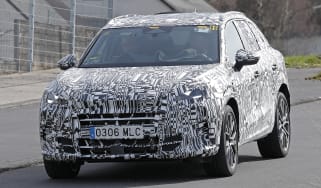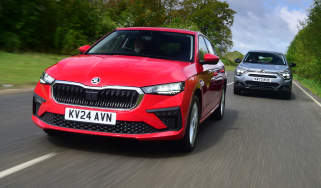Can virtual reality cars replace motorsport as we know it?
We strap on some virtual-reality goggles and take a 400bhp electric race car for a spin around the ‘Circuit de Catalunya’
Global motor racing has a colossal carbon footprint, that much is true. And although more environmentally friendly alternatives – such as Formula E – are gaining traction, there’s plenty of work still to be done.
While not quite the same as driving a real car on a real circuit, simulator racing has taken off in recent years. Cult classics such as Gran Turismo and Forza Motorsport now host huge online championships – allowing Joe Public to compete against on-screen strangers on the other side of the globe, all from the comfort of their own home.
But what if you could experience the thrill of track driving, in a physical, 400bhp race car going toe to toe with the best drivers on the planet, without setting foot on a plane or travelling hundreds of miles with a team of engineers?
Cupra says this is a “new reality for motorsports”. The brand calls it the Exponential Experience; using the electric UrbanRebel Racing concept, a virtual-reality (VR) headset and an empty airfield, it hopes to create an uniquely immersive track-driving experience. Suitably intrigued, we’ve headed to Germany to try it out.
The concept was revealed at the Berlin E-Prix earlier this year, when Xavi Serra, head of Cupra Racing said: “The Cupra Exponential Experience brings to life something most drivers wouldn’t typically experience: a unique racing concept merging the virtual and physical worlds.
“Drivers can strap on an HD headset and forget about reality as they race through a virtual world, travelling from Barcelona to Berlin – or any scenario imaginable.”
Feeling somewhat overdressed in a pair of smart shoes and chinos, it isn’t the day to be setting any lap records. This is especially true as we climb in next to French racing driver and eTouring Car champ Adrien Tambay, who is kind enough not to comment on our sub-standard attire.
The UrbanRebel may be a concept, yet it feels anything but as we sit deep within the sculpted race seats and behind a steering wheel with ‘launch’, ‘radio’ and ‘pit’ buttons on it. There is a small digital screen ahead of the driver, and a 12 o’clock marker on the wheel – not that we’ll need it, as the Cupra team quickly clamber in to affix the bulky headset.
Apart from feeling a bit top-heavy, once the glasses are on, the detailed surroundings immediately transport you somewhere new. The graphics are more arcade-like than expected, but even before moving forward you can spot raised Armco, kerbs, and mock-up billboards – an almost cartoon-like version of what you’d find at a real track.
While you wouldn’t know it from the briefing hut, the track here is modelled on the Circuit de Barcelona-Catalunya in Spain. Indeed, all you can see without the headset on is an open airfield with planes taxiing in the distance.
Tambay has his own screen directly in front of him, allowing visuals of what I’m seeing in real time. He’s quick to allay any fears that a set-up like this might make even those with a steel stomach feel a little queasy: “It feels surprisingly natural,” he tells us.
He’s not wrong. If it were even fractionally out of kilter, the forces placed on your body wouldn’t match with what you see in front of you. But as soon as we move off, the VR headset syncs perfectly with the inertia you feel, and the set-up works seamlessly.
The car isn’t slow, either. After two sighting laps – again, just following a make-believe route around an empty piece of tarmac – Tambay encourages us to up the pace. Quite unlike some of the million-dollar one-off prototypes we’ve tried in our time, the UrbanRebel feels sharp as a knife, with quick steering and a loud whine from the aggressive motor.
As we run through a checkpoint, the graphics turn from day to night, giving the impression we’re driving the famous Formula One track under floodlights. There’s plenty of purple and yellow – plus arrows showing us where to go – to stop it feeling too lifelike, but again, the overwhelming sensation is of how alarmingly familiar it all seems.
Through each lap there is an area that, in effect, operates under safety-car conditions, a section between two corners that in real life, is considered a little too close to the perimeter fence to allow access to the Cupra’s full power output. Given how ‘online’ these cars are, it’d be fairly straightforward to also include a Formula E-style Fanboost scenario, too, whereby the racer receives a temporary power upgrade for a defined period of time.
As impossible as it seems, there is not a hint of motion sickness. The powerful processor works in real time; the instant you move your head, the world inside the goggles shifts too. Every input is perfectly mimicked on the live stream, and as such, feels utterly intuitive.
Our first recommendation would be to implement a more photorealistic track set-up; we’re so used to sharp-as-you-like racing sims that the Ridge Racer-style graphics feel at odds with the cutting-edge tech. We’d love to try a variety of tracks, too, just to see how versatile the system can be, and how the different layouts appear unique on what is ostensibly an identical section of hard-standing. But it’s early in its development, and these kind of things could be added to the system in time.
So what’s the point? According to the people who are masterminding the project, Cupra’s Exponential Experience allows “the emotion of driving” to meet “the limitless potential and imagination of the virtual world”. In short, you could have Tambay at home in France, with his Kiwi equivalent enjoying an identical layout somewhere in the Auckland suburbs on the other side of the world.
That much is true, but its commercial viability is something else – not only do all the participants need an identical car, they also need an area of land big enough to run the designated track. Then there are things like weather, temperature and surfaces to consider. It’s easy to ensure a level playing field when you have 20 cars on a track in one place, another job entirely when they’re all over the world.
But Cupra bosses “want to be ready” for whatever form the future of motorsport presents itself in – and there’s no denying its interest in a world dominated by youngsters who’ve grown up playing Xbox in their bedrooms. And you only need to look at the popularity of online streaming – via YouTube or Twitch – to dismiss any concerns that people simply wouldn’t tune in to watch.
Do you think virtual reality motorsport will take off? Let us know your thoughts in the comments section...











